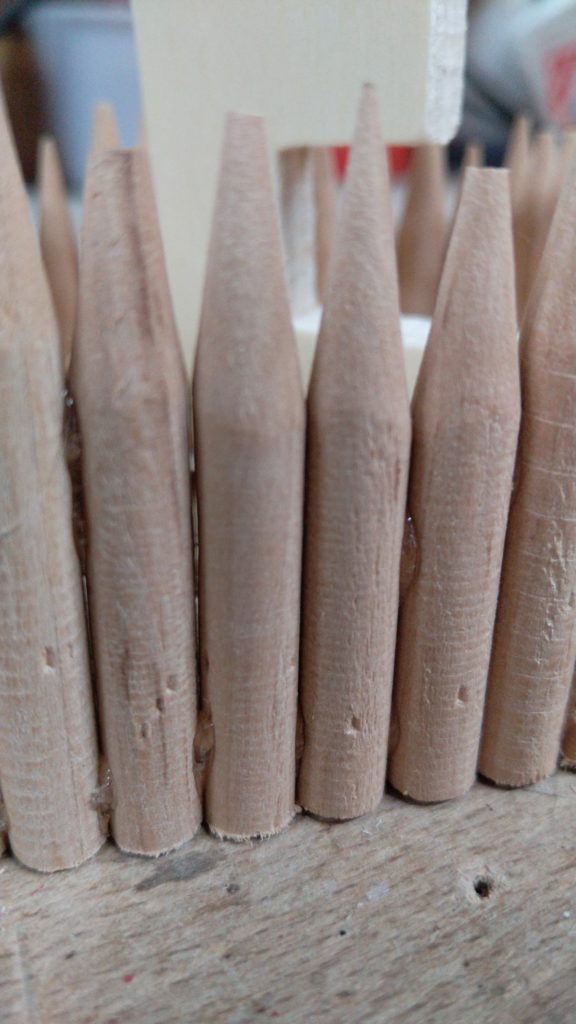Dowels – round, long pieces – are a very versatile administration form of wood. They have their use in fine woodworking as well as crafting. And the best part? You can easily make your own!
What are Wood Dowels good for?
Since the grain runs along their axis they are pretty sturdy and tend not to break easily. This makes them a great choice for joinery, but also for patches and repairs. And so much more!


Here is a non-exclusive list of all the things you can do with dowels:
- You can cover mistakes – like screw holes or small gaps in a glue-up – by drilling a larger hole into the material and glue a piece of dowel in place. Cut it off and sand it flush. Done.
- Dowels are a great way to strengthen joinery connections (just like “biscuits” and “dominos”, but without dedicated tools). One way that I learned from Marius Hornberger is to use 2-3 screws to pull two pieces together while the glue dries, then remove one screw at a time, drill a hole in its place and glue in a dowel.
- You can also use dowels to hide screws. For that, sink your screw using a drill bit the size of your dowel stock. Once the screw is in place you can plug the hole using the dowel. Then either sand it flat to hide it, or leave it proud for later maintenance.
- Dowel stock, especially from different species of wood, can be used to great decorative effect. For that, simply drill a hole insert the dowel and sand it flush. Here is a great example by Maurice Block, an oak swing that he made for the Challenge Tree 2015.
- build things
Why make them yourself?
You can buy wood dowels. So why go through the (slight) hassle of making it yourself? There are a couple of advantages to this. The most obvious one is that you can match the wood to your projects if you make your own. If you have connections where the dowel is visible from the outside or, worse protrudes as an artistic element, you may want to use dowels made from the same stock you are building with – or a different, contrasting one.
There are also some species of wood that you probably cannot buy as dowels, no matter how hard you try. This is especially true if you are working either with exotics shipped from far away or the other kind of exotics that grow in your garden but nobody bothers with commercially.
And depending on the amount you need, you can save money by making your own dowels! If you only need a few you do not need to make a trip to the local home improvement store. and if you need a lot, making your own is most likely cheaper.
The simple Jig
The easiest method to make your own dowels is to take a metal plate and drill a hole into it with the desired size of the dowel. If you want to make things a little easier you can then rough up the top surface around the hole with a file or even a rotary tool.
Now you need long pieces of wood slightly larger than the diameter of the hole. I like to cut mine on the table saw. I then “sharpen” one end using a knife and insert the other into my drill. The pointy-ish end placed into the hole I let the dowel rotate and push it through the place (with feeling as to not break the rod it). You can see the process in this video.
If you need different dowel sizes you can easily use the same piece of metal to drill different sized holes into it.
The Dowel Cutter
With these “inverse drills” you can cut a hole into a thicker board, leaving the desired dowel standing in the center. Then you can either use a bandsaw, a handsaw or brute force to remove the dowel and use it to plug holes or as a decorative element.
A set of Dowel Cutters (this is an affiliate link) allows you to make most common sizes of dowels. This is a great solution if you want versatility but not go too deep into jig-making. Also, keep in mind that you can only make short dowels with them. They should be enough for most applications, though.
More involved Methods
I am quite content with the homemade dowel plate, and the dowel cutters are a great solution if you’d rather buy something that works. But there are many other methods of making wood dowels. For your inspiration, here is Izzy Swan with two methods that might fit your style of woodworking.
First, this small jig is probably the fastest of them all, literally hammering the point home.
His other doweling jig relies on a sharp chisel and can be adapted for any desired hole size, including stock diameters that the others methods would struggle with.
I hope you found the information herein heplful. Embark on your dowel-making journey. I cannot help but hope that you do well. See what I did there? Don’t forget to check out a few more projects!
Please share this resource if you found it helpful, and Be Inspired!
Inspire your inbox!
Subscribe and never miss a project!
Thank you for subscribing!
Something went wrong...
We respect your privacy and take protecting it seriously!
